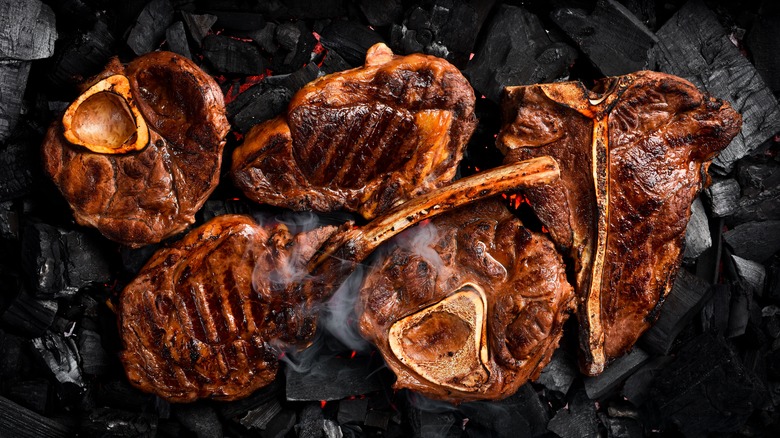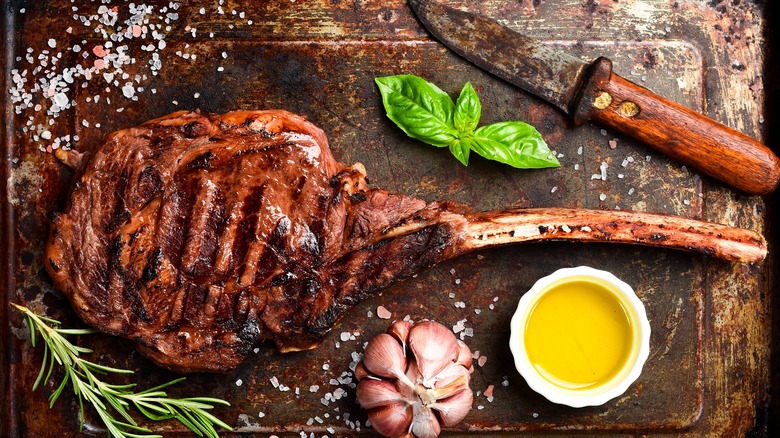The Key Differences To Know Between Tomahawk Vs Porterhouse Steak
We may receive a commission on purchases made from links.
A steak dinner is a special occasion for many, and that means looking for the highest quality to cut of steak to make it count. Porterhouse and tomahawk steaks are two cuts of steak you're likely to find on steakhouse menus. They're both impressive to look at with a flavor to match, but there are many key differences. Tasting Table has consulted Chef K.C. Gulbro, owner of Foxfire and Copper Fox and Ambassador for Certified Angus Beef, to shed some light on their distinctions.
However, before breaking down their differences, Chef Gulbro first highlighted the similarities and overlaps in cooking methods. "Both of these steaks are great for grilling and pair well with compound butter to enhance flavor," he said. If you don't have an outdoor grill, you should invest in a grill pan like this Sensarte nonstick grill pan or this Lodge cast iron square.
One of the most obvious shared characteristics is their large size. "Both steaks are ideal for sharing, and we would suggest pre-slicing before serving," Chef Gulbro said. Since the two cuts both surround a large bone, he opts to keep the bone on the serving dish for a show-stopping presentation. "[C]ut the steak whole off the bone, slice it, and then reconstruct it on the plate with the bone," the chef advised. As with most cuts of umami-rich steaks, you can't go wrong with a complementary sauce like this easy chimichurri or something creamier like this lemony hollandaise sauce.
Porterhouse steak key characteristics
One of the highest-ranking varieties on our list of popular cuts of steak, the porterhouse is also one of Chef K.C. Gulbro's favorites. "The porterhouse is a wonderful cut – it consists of two of the most popular steakhouse steaks: the New York Strip (or sirloin) and filet," he said. So, you get an ultra-tender melt-in-your-mouth cut with the filet and a more flavorful cut with a meatier chew from the New York Strip.
When it comes to purchasing a Porterhouse from your local butcher, "A porterhouse should have at least 1 ½ inch of filet or more near the bone," the chef continued. "Anything less is considered a T-BONE (which typically ranges from 1.25 to 0.5 inches), and there is a difference." After all, you want the best of each cut's flavor and texture. Chef Gulbro also notes that the butcher may cut out the vein found on the sirloin side, but you can also request them to leave the vein in to cut it out yourself and serve it as a "vein steak" for salads or sandwiches.
You can use vein steak in this steak salad recipe by Giada de Laurentiis or serve it on a sandwich with any number of gourmet toppings like this steakhouse horseradish sauce or a bright and tangy tomato chutney. Whether you're ordering porterhouse from your butcher or at a steakhouse, "Steak gains flavor from the marrow in the "T" bone, which is why bone-in steaks are sometimes preferred by steak lovers," as Gulbro explained.
Tomahawk steak characteristics and distinctions
A cut surrounding the cow's massive rib bone, the tomahawk is, according to Chef K.C. Gulbro, similar to a Cowboy cut. "It's a large ribeye with a bone that can measure from 1-4 feet," he said. Tomahawks have great marbling, equating to an ultra-rich flavor and high-quality tenderness. The porterhouse surrounds a T-bone, which contributes to its flavor and juiciness. "It delivers both awe and shock," Gulbro explained. "The awe comes from how amazing it looks on the plate, giving it a serious wow factor, but the shock comes from the price. You have to pay for the extra weight of the bone, which can add a pound or two to the cost." If you're willing to shell out those extra dollars, the taste is as impressive as the presentation.
Despite both cuts of steak lending well to grilling, "The porterhouse can be basted, [but] the Tomahawk is a bit harder to baste due to its size," per Gulbro. That said, the Tomahawk's ample marbling will maintain its juiciness on the grill. Plus, you can cut that giant and impressive ribeye bone in half to unveil a wealth of decadent marrow. A butcher knife like this Kyoku Samurai knife will easily cut through the bone.
Like roasting, grilling bone marrow is a great way to amplify its flavor while also adding a layer of smokiness. You can make bone marrow last by incorporating a portion of it into this recipe for bone marrow butter with Meyer lemon and chives.


